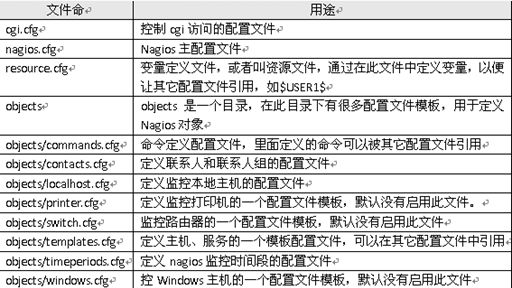运维监控利器Nagios之:nagios配置详解
转自:http://ixdba.blog.51cto.com/2895551/752870
- define contact{
- name generic-contact #联系人名称,
- service_notification_period 24x7 #当服务出现异常时,发送通知的时间段,这个时间段“7x24"在timeperiods.cfg文件中定义
- host_notification_period 24x7 #当主机出现异常时,发送通知的时间段,这个时间段“7x24"在timeperiods.cfg文件中定义
- service_notification_options w,u,c,r #这个定义的是“通知可以被发出的情况”。w即warn,表示警告状态,u即unknown,表示不明状态,c即criticle,表示紧急状态,r即recover,表示恢复状态。也就是在服务出现警告状态、未知状态、紧急状态和重新恢复状态时都发送通知给使用者。
- host_notification_options d,u,r #定义主机在什么状态下需要发送通知给使用者,d即down,表示宕机状态,u即unreachable,表示不可到达状态,r即recovery,表示重新恢复状态。
- service_notification_commands notify-service-by-email #服务故障时,发送通知的方式,可以是邮件和短信,这里发送的方式是邮件,其中“notify-service-by-email”在commands.cfg文件中定义。
- host_notification_commands notify-host-by-email #主机故障时,发送通知的方式,可以是邮件和短信,这里发送的方式是邮件,其中“notify-host-by-email”在commands.cfg文件中定义。
- register 0
- }
- define host{
- name generic-host #主机名称,这里的主机名,并不是直接对应到真正机器的主机名,乃是对应到在主机配置文件里所设定的主机名。
- notifications_enabled 1
- event_handler_enabled 1
- flap_detection_enabled 1
- failure_prediction_enabled 1
- process_perf_data 1
- retain_status_information 1
- retain_nonstatus_information 1
- notification_period 24x7 #指定“发送通知”的时间段,也就是可以在什么时候发送通知给使用者。
- register 0
- }
- define host{
- name linux-server #主机名称
- use generic-host #use表示引用,也就是将主机generic-host的所有属性引用到linux-server中来,在nagios配置中,很多情况下会用到引用。
- check_period 24x7 #这里的check_period告诉nagios检查主机的时间段
- check_interval 5 #nagios对主机的检查时间间隔,这里是5分钟。
- retry_interval 1 #重试检查时间间隔,单位是分钟。
- max_check_attempts 10 #nagios对主机的最大检查次数,也就是nagios在检查发现某主机异常时,并不马上判断为异常状况,而是多试几次,因为有可能只是一时网络太拥挤,或是一些其他原因,让主机受到了一点影响,这里的10就是最多试10次的意思。
- check_command check-host-alive #指定检查主机状态的命令,其中“check-host-alive”在commands.cfg文件中定义。
- notification_period workhours #主机故障时,发送通知的时间范围,其中“workhours”在timeperiods.cfg中进行了定义,下面会陆续讲到。
- notification_interval 120 #在主机出现异常后,故障一直没有解决,nagios再次对使用者发出通知的时间。单位是分钟。如果你觉得,所有的事件只需要一次通知就够了,可以把这里的选项设为0
- notification_options d,u,r #定义主机在什么状态下可以发送通知给使用者,d即down,表示宕机状态,u即unreachable,表示不可到达状态,r即recovery,表示重新恢复状态。
- contact_groups admins #指定联系人组,这个“admins”在contacts.cfg文件中定义。
- register 0
- }
- define service{
- name generic-service #定义一个服务名称
- active_checks_enabled 1
- passive_checks_enabled 1
- parallelize_check 1
- obsess_over_service 1
- check_freshness 0
- notifications_enabled 1
- event_handler_enabled 1
- flap_detection_enabled 1
- failure_prediction_enabled 1
- process_perf_data 1
- retain_status_information 1
- retain_nonstatus_information 1
- is_volatile 0
- check_period 24x7 #这里的check_period告诉nagios检查服务的时间段。
- max_check_attempts 3 #nagios对服务的最大检查次数。
- normal_check_interval 10 #此选项是用来设置服务检查时间间隔,也就是说,nagios这一次检查和下一次检查之间所隔的时间,这里是10分钟。
- retry_check_interval 2 #重试检查时间间隔,单位是分钟。
- contact_groups admins #指定联系人组,同上。
- notification_options w,u,c,r #这个定义的是“通知可以被发出的情况”。w即warn,表示警告状态,u即unknown,表示不明状态,c即criticle,表示紧急状态,r即recover,表示恢复状态。也就是在服务出现警告状态、未知状态、紧急状态和重新恢复后都发送通知给使用者。
- notification_interval 60 #在服务出现异常后,故障一直没有解决,nagios再次对使用者发出通知的时间。单位是分钟。如果你认为,所有的事件只需要一次通知就够了,可以把这里的选项设为0。
- notification_period 24x7 #指定“发送通知”的时间段,也就是可以在什么时候发送通知给使用者。
- register 0
- }
- $USER1$=/usr/local/nagios/libexec
其中,变量$USER1$指定了安装nagios插件的路径,如果把插件安装在了其它路径,只需在这里进行修改即可。需要注意的是,变量必须先定义,然后才能在其它配置文件中进行引用。
- define host{
- host_name ixdba
- address 192.168.12.246
- check_command check_ping
- ...
- }
- define command{
- command_name check_ping
- command_line /usr/local/nagios/libexec/check_ping -H $HOSTADDRESS$ -w 100.0,90% -c 200.0,60%
- }
- /usr/local/nagios/libexec/check_ping -H 192.168.12.246 -w 100.0,90% -c 200.0,60%
- define service{
- host_name linuxbox
- service_description PING
- check_command check_ping!200.0,80%!400.0,40%
- ...
- }
- define command{
- command_name check_ping
- command_line /usr/local/nagios/libexec/check_ping -H $HOSTADDRESS$ -w $ARG1$ -c $ARG2$
- }
- /usr/local/nagios/libexec/check_ping -H 192.168.12.246 -w 200.0,80% -c 400.0,40%
- #下面是notify-host-by-email命令的定义
- define command{
- command_name notify-host-by-email #命令名称,即定义了一个主机异常时发送邮件的命令。
- command_line /usr/bin/printf "%b" "***** Nagios *****\n\nNotification Type: $NOTIFICATIONTYPE$\nHost: $HOSTNAME$\nState: $HOSTSTATE$\nAddress: $HOSTADDRESS$\nInfo: $HOSTOUTPUT$\n\nDate/Time: $LONGDATETIME$\n" | /bin/mail -s "** $NOTIFICATIONTYPE$ Host Alert: $HOSTNAME$ is $HOSTSTATE$ **" $CONTACTEMAIL$ #命令具体的执行方式,“-H $HOSTADDRESS$” 是定义目标主机的地址,这个地址在hosts.cfg文件中定义了。
- }
- #下面是notify-host-by-email命令的定义
- define command{
- command_name notify-service-by-email #命令名称,即定义了一个服务异常时发送邮件的命令
- command_line /usr/bin/printf "%b" "***** Nagios *****\n\nNotification Type: $NOTIFICATIONTYPE$\n\nService: $SERVICEDESC$\nHost: $HOSTALIAS$\nAddress: $HOSTADDRESS$\nState: $SERVICESTATE$\n\nDate/Time: $LONGDATETIME$\n\nAdditional Info:\n\n$SERVICEOUTPUT$" | /bin/mail -s "** $NOTIFICATIONTYPE$ Service Alert: $HOSTALIAS$/$SERVICEDESC$ is $SERVICESTATE$ **" $CONTACTEMAIL$
- }
- #下面是notify-host-by-email命令的定义
- define command{
- command_name check-host-alive #命令名称,用来检测主机状态。
- command_line $USER1$/check_ping -H $HOSTADDRESS$ -w 3000.0,80% -c 5000.0,100% -p 5 #这里的变量$USER1$在resource.cfg文件中进行定义,即$USER1$=/usr/local/nagios/libexec
- ,那么check_ping的完整路径为/usr/local/nagios/libexec/check_ping。 “-w 3000.0,80%”中“-w”说明后面的一对值对应的是“WARNING”状态,“80%”是其临界值。“-c 5000.0,100%”中“-c”说明后面的一对值对应的是“CRITICAL”,“100%”是其临界值。“-p 1”说明每次探测发送一个包。
- }
- #下面是notify-host-by-email命令的定义
- define command{
- command_name check_ftp
- command_line $USER1$/check_ftp -H $HOSTADDRESS$ $ARG1$ #$ARG1$是指在调用这个命令的时候,命令后面的第一个参数。
- }
- #下面是check_http命令的定义
- define command{
- command_name check_http
- command_line $USER1$/check_http -I $HOSTADDRESS$ $ARG1$
- }
- #下面是check_ssh命令的定义
- define command{
- command_name check_ssh
- command_line $USER1$/check_ssh $ARG1$ $HOSTADDRESS$
- }
- define host{
- use linux-server #引用主机linux-server的属性信息,linux-server主机在templates.cfg文件中进行了定义。
- host_name web #主机名
- alias ixdba-web #主机别名
- address 192.168.12.251 #被监控的主机地址,这个地址可以是ip,也可以是域名。
- }
- ?
- define host{
- use linux-server
- host_name mysql
- alias ixdba-mysql
- address 192.168.12.237
- }
- ?
- define hostgroup{ #定义一个主机组
- hostgroup_name sa-servers #主机组名称,可以随意指定。
- alias sa servers #主机组别名
- members web,mysql #主机组成员,其中“web”、“mysql”就是上面定义的两个主机。
- }
- ################# ixdba web #####################
- define service{
- use local-service #引用local-service服务的属性值,local-service在templates.cfg文件中进行了定义。
- host_name web #指定要监控哪个主机上的服务,“web”在hosts.cfg文件中进行了定义。
- service_description PING #对监控服务内容的描述,以供维护人员参考。
- check_command check_ping!100.0,20%!500.0,60% #指定检查的命令,check_ping命令在commands.cfg中定义,后跟两个参数,命令与参数间用!分割。
- }
- define service{
- use local-service
- host_name web
- service_description SSH
- check_command check_ssh # check_ssh命令也在commands.cfg中定义。
- }
- define service{
- use local-service
- host_name web
- service_description SSHD
- check_command check_tcp!22
- }
- define contact{
- contact_name sasystem #联系人名称
- use generic-contact #引用generic-contact的属性信息,其中“generic-contact”在templates.cfg文件中进行定义
- alias sa-system #联系人别名
- email [email protected] #联系人的邮件地址
- }
- define contactgroup {
- contactgroup_name admins #联系人组名称
- alias system administrator group #联系人组描述
- members sasystem #联系人组成员,其中“sasystem”就是上面定义的联系人
- }
- #下面是定义一个名为24x7的时间段,即监控所有时间段
- define timeperiod{
- timeperiod_name 24x7
- alias 24 Hours A Day, 7 Days A Week
- sunday 00:00-24:00
- monday 00:00-24:00
- tuesday 00:00-24:00
- wednesday 00:00-24:00
- thursday 00:00-24:00
- friday 00:00-24:00
- saturday 00:00-24:00
- }
- #下面是定义一个名为workhours的时间段,即工作时间段。
- define timeperiod{
- timeperiod_name workhours
- alias Normal Work Hours
- monday 09:00-17:00
- tuesday 09:00-17:00
- wednesday 09:00-17:00
- thursday 09:00-17:00
- friday 09:00-17:00
- }
- default_user_name=ixdba
- authorized_for_system_information=nagiosadmin,ixdba
- authorized_for_configuration_information=nagiosadmin,ixdba
- authorized_for_system_commands=ixdba
- authorized_for_all_services=nagiosadmin,ixdba
- authorized_for_all_hosts=nagiosadmin,ixdba
- authorized_for_all_service_commands=nagiosadmin,ixdba
- authorized_for_all_host_commands=nagiosadmin,ixdba
- log_file=/usr/local/nagios/var/nagios.log
- “log_file”变量用来定义nagios日志文件的路径。
- cfg_file=/usr/local/nagios/etc/hosts.cfg
- cfg_file=/usr/local/nagios/etc/services.cfg
- cfg_file=/usr/local/nagios/etc/commands.cfg
- cfg_file=/usr/local/nagios/etc/contacts.cfg
- cfg_file=/usr/local/nagios/etc/timeperiods.cfg
- cfg_file=/usr/local/nagios/etc/templates.cfg
- “cfg_file”变量用来引用对象配置文件,如果有更多的对象配置文件,在这里依次添加即可。
- object_cache_file=/usr/local/nagios/var/objects.cache
- 该变量用于指定一个“所有对象配置文件”的副本文件,或者叫对象缓冲文件
- resource_file=/usr/local/nagios/etc/resource.cfg
- 该变量用于指定nagios资源文件的路径,可以在Nagios.cfg中定义多个资源文件。
- status_file=/usr/local/nagios/var/status.dat
- 该变量用于定义一个状态文件,此文件用于保存nagios的当前状态、注释和宕机信息等。
- status_update_interval=10
- 该变量用于定义状态文件(即status.dat)的更新时间间隔,单位是秒,最小更新间隔是1秒。
- nagios_user=nagios
- 该变量指定了Nagios进程使用哪个用户运行。
- nagios_group=nagios
- 该变量用于指定Nagios使用哪个用户组运行。
- check_external_commands=1
- 该变量用于设置是否允许nagios在web监控界面运行cgi命令,也就是是否允许nagios在web界面下执行重启nagios、停止主机/服务检查等操作。“1”为运行,“0”为不允许。
- command_check_interval=2
- 该变量用于设置nagios对外部命令检测的时间间隔,如果指定了一个数字加一个"s"(如10s),那么外部检测命令的间隔是这个数值以秒为单位的时间间隔。如果没有用"s",那么外部检测命令的间隔是以这个数值的“时间单位”的时间间隔。
- interval_length=60
- 该变量指定了nagios的时间单位,默认值是60秒,也就是1分钟,即在nagios配置中所有的时间单位都是分钟。
